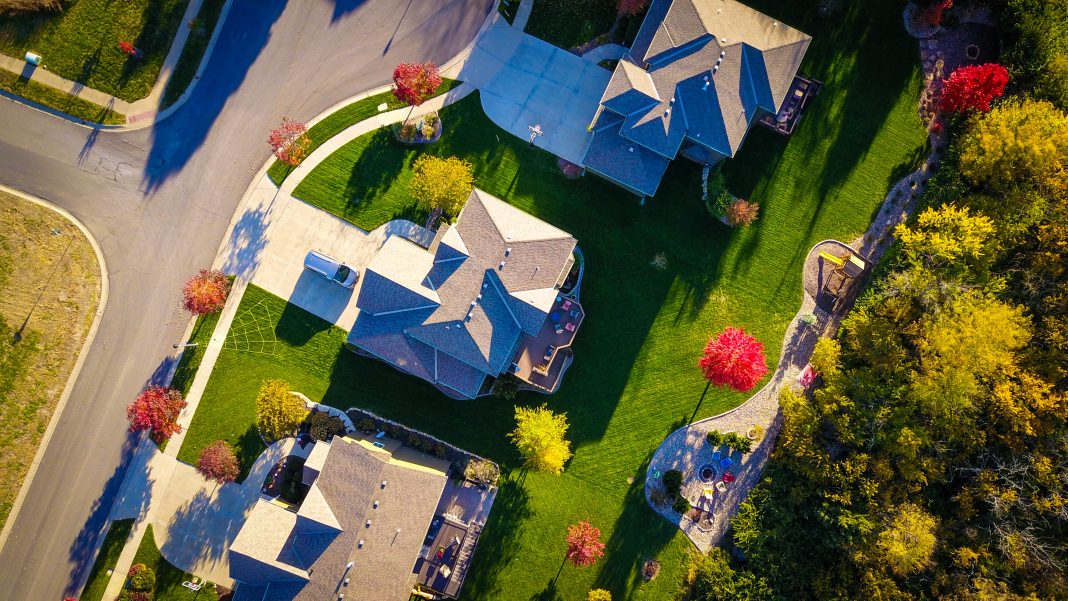A grand single-family house in the suburbs with a nice garden and a big garage at the end of a long driveway where two cars easily fit – that is an aspiration of many North Americans, spawned by the concept of the American Dream. However, this idealisation lacks future vision and the shift to multi-family housing is inevitable.
The American Dream – a concept most people in the world have heard of. And whether you live in North America or have seen any Hollywood movie ever, you know that owning a single-family house with a great garden in a nice neighbourhood, ideally with a garage big enough for two cars, has been viewed as the greatest achievement for households in post-war America.
Most detached North American single-family houses are located in the suburbs: residential districts located in the outskirts of metropolitan areas where, characteristically, public transportation is non-existent and big gardens, pools, and low traffic congestion seemingly make for a happy neighbourhood. That at least is the image portrayed in the media and by the people owning a home there. However, this is not the reality for everyone. Before we discuss the problems of single-family housing, we take a look on how the North American suburbs came to be…
A Story of Suburban Life
The first suburbs developed between 1900 and 1930, not far from the city centre. These so-called inner-ring suburbs were created when veterans received low-cost mortgages and many acres were made available to new housing developments.
Following the second world war, owning a house in the suburbs was the ultimate aspiration. Homeownership was then, and for some still is today, a classic representation of the American Dream. In these suburbs, good education, low crime, and autonomy was a kept promise. It was, quite frankly, the chance for white residents to escape social tensions in large cities, which were caused by a growing population of minority groups after the war. This led to the so-called white flight: white middle-class residents living in the inner-ring suburbs escaped to newer ones further out of the city in the 1970s and ‘80s.
And in the ‘90s, when minorities aspiring to the exact same version of the American Dream followed in the suburbs, white residents again left to newer, bigger, even more spacious areas further from downtown. Jim Crow Laws might not exist anymore, but segregation is very much still an issue.
This great segregation, however, was not just caused by social tension but was further fuelled by political decisions and policies. For years, politics have favoured single-family houses with zoning regulations that prevent the construction of multi-family apartments on single lots.
Moreover, many US banks backed by the government denied mortgages to minority populations to keep them from buying houses in specific neighbourhoods. This practice, called redlining, has since been outlawed but its effects are still visible today.
Not in My Backyard
Let’s be clear, with the growing trend of urbanisation and overall population growth, we simply do not have space for everyone to live in a single-family home. Still, the stigma North Americans have against multi-family housing is immense. Especially if you compare it to European cities, where multi-family units are in many areas a no-brainer. As Naama Blonder, co-founder and architect of Smart Density in Toronto asserts: “This concept of living in a four-bedroom apartment does not exist. And I am not exaggerating, it just doesn’t exist.”
Additionally, even though it would help tackle the housing crisis, multigenerational living is often stigmatised as well.
Opponents to developments like multi-family apartment constructions in their local area are often explained by the NIMBY (‘Not in my backyard’) phenomenon. This opposition group alone could be the subject of a completely new article! Broken down, it means people oppose developments in an area close to where they live. Distant developments are not an issue.

One argument brought up frequently is that people who live in apartments are less desirable neighbours and more likely to be perpetrators of crime or anti-social behaviour. Ironic how people living in a home with many other families are supposed to be anti-social. It is an argument fuelled by years of systemic racism and classicism without the backing of scientific evidence.
Moreover, people living in single-family houses fear that multi-family houses overburden schools and require more infrastructure support. The reality is that apartments in multi-family houses are very attractive to single people, couples without children, and the elderly who no longer need a single-family home. On average there are fewer children in 100 apartments than in 100 single-family homes, hence overburdened schools can’t really be the fault of multi-family houses.
If you want to see other arguments, such as multi-family houses decrease the value of single-family ones in the area, debunked, check out this 2007 paper on ‘Overcoming Opposition to Multifamily Rental Housing’.
Why North America Needs to Focus on Multi-Family Houses
Rather than checking the opponents’ arguments, let’s focus on why multi-family houses should be replacing suburban single-family houses.
As said, redlining is a tool that is not legal anymore, however, like white flight, it has led to a segregation between white residents and residents of colour. The fact that newer suburbs kept on being built ‘better’ and bigger resulted in an imbalance of opportunities. The new, spacious suburbs were wonderfully maintained, while the inner rings lacked investment, but offered more affordable housing options. This led to segregation between middle-class and low-income families, often White and Black residents, respectively.
These low-income and communities of colour are also disproportionately more affected by climate changes, for instance during heat waves as many households can’t afford air conditioning. Hence, a shift to multi-family houses and a cessation of zoning regulations could end segregation and furthermore mitigate the climate impact for low-income residents and people of colour. Additionally, the average energy consumption in single-family housing is bigger than the usage in multi-family houses, so the latter can also help prevent energy poverty.

Maybe the most obvious pitch for multi-family housing is the fact that we don’t have enough space for everyone to live in single-family house! Unlike many developing regions, the population in North America is growing. Metropolitan cities are getting bigger and bigger. As Naama, living in Canada herself, asserts: “Toronto is now the fourth largest city in North America. And we’re growing so fast that we’ve surpassed Chicago, and we will pass LA in the next 25 years”.
Not only do we not have the space, but we also don’t have the money for single-family homes. If you are a millennial, you might have had this discussion with your parents or your grandparents before: for many, buying a house is no longer an option. “What the previous generations could afford is no longer affordable for our generation”, says Naama. This is not only true for North America; housing affordability presents a growing and pressing issue almost everywhere in the world.
Overall, we need to change the paradigm that suburban life is the ultimate key to a happy lifestyle, when actually, according to a survey from the UK, inner city life makes people happier and healthier. Contrary to popular belief, downtown residents are much more active and socially more engaged, while suburban areas have the highest rates of obesity and lowest rates of exercise. Multi-family houses would allow more people to live in inner cities, where not only most jobs can be found, but also the educational opportunities and transit options are much better.
What to Do Now?
In North America, a whole paradigm shift has to happen – away from the American Dream of suburban life towards the dynamic urban inner-city life. With workshops and seminars, Naama is taking the first steps. “It’s all about educating the market,” she explains, “I’m trying to have the conversation as wide as possible.” Still, it will take a while to change people’s perspective, especially because it often isn’t yet even a conversation that people are willing to indulge.
However, recent policy proposals in the US might change that. US President Biden actually plans on limiting single-family housing and invest more into multi-family apartments. He aims to put an end to single-family zoning by offering grants and tax credits to cities that change their zoning laws. Minneapolis already put a plan into action in January 2020 that will change its zoning rules and legalise duplexes, etc., in neighbourhoods formerly reserved for single-family homes. Changing one’s behaviour is a difficult challenge, hence, policies might nudge North Americans in the right direction.
By the way, there are examples of how to avoid segregation in suburbanisation. In the inner-ring suburbs of Oak Park, Chicago and Shaker Heights, Cleveland, a race-conscious tactic was taken in the ‘60s when social tensions raised as Black people left their segregated Chicago neighbourhoods to move into the suburbs.
Community relations commissions were established to have conversations about race between the residents and to debunk rumours about other communities. White residents who welcomed Black neighbours were actively sought out and encouraged newcomers to spread out through the village and not cluster by race.
In a Nutshell…
Considering inner-city multi-family houses, people need to understand that they are not settling for an apartment without a garden but gaining a place to live surrounded by diverse groups of people, close to everything they need in life without ever needing to grasp their car key.
It will take a while to change the long-aspired ideal of the American suburban life, but it is worth it to make sure everyone can afford to live in a home close to their jobs and schools in a vibrant neighbourhood.


